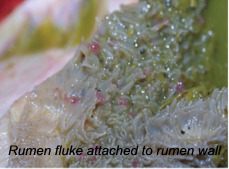Rumen Fluke - All You Need to Know
 It is widely known that snails and slugs have a natural aversion to copper, which is why hosta plants (a slug's favourite!) grown in pots are protected by copper bands wrapped around the base of the pot. The snails and slugs will not pass this band!
It is widely known that snails and slugs have a natural aversion to copper, which is why hosta plants (a slug's favourite!) grown in pots are protected by copper bands wrapped around the base of the pot. The snails and slugs will not pass this band!
The application of Field Science tailor-made trace element dressings ensures that the correct level of copper is in the rootzone of any treated soil and this deters the host snail (be it water snail or ramshorn snail) from remaining on that soil, thus breaking the fluke's life cycle.
The following article was written by Dr Theo De Waal, a member of the AHI Technical Working Group on Parasite Control at www.animalhealthireland.ie. It gives an excellent insight into the life cycle and issues surrounding this parasite:
Introduction
The increased incidence of rumen fluke eggs in dung samples submitted to the regional veterinary laboratories in Ireland has sparked a renewed interest in this parasite.
How is this parasite transmitted?
The life history of these parasites is similar to that of liver fluke, as they also require a snail as intermediate host to complete their life cycle. However, the rumen fluke utilize a different snail as intermediate host. This is a water snail (ramshorn snail) found in well vegetated rivers, lakes, canals, and ponds.
The adult rumen flukes live in the stomach of cattle and sheep where they produce eggs which are passed in the dung. Larvae, which hatch from eggs that developed in a wet and warm environment, infect the intermediate snail host. The larvae continue their development in the snail, and when mature, leave the snail and attach to the surface of the surrounding vegetation where they become encased. Here they can remain viable for up 6 months. Infected snails can live and shed the parasite for up to 1 year.
Cattle and sheep become infected when they graze on vegetation containing the parasite. The immature flukes attach themselves to the walls of the small intestine where they grow rapidly. After about 3-6 weeks they migrate and attach to the wall of the rumen. Here they will reach the adult stage and produce eggs.
How would I recognise this disease?
The adult flukes are well tolerated in the rumen and generally believed not to cause clinical disease in livestock in Ireland. In many instances the presence of rumen fluke in animals in poor condition or suffering from ill thrift is also complicated by other parasitic or nutritional disease.
Heavy burdens of immature flukes in the small intestine may sometimes cause acute disease, characterized by loss in appetite, listlessness and general weakness. Profuse, foul-smelling, watery diarrhoea (sometimes projectile) develops 2-4 weeks after infection.
When does disease occur?
Outbreaks of disease generally occur in the drier months of the year when the receding water uncovers vegetation contaminated with the parasite. In the UK, it has been suggested that flooding and/or the changing farm management practices may have caused the parasite to become more widely distributed than in the past. Acute disease is usually seen in young cattle less than 2 years of age. Sheep appear susceptible throughout their lives.
Should animals be treated?
The need for treatment must be carefully evaluated as the presence of adult flukes in the rumen or eggs in the faeces is not indicative of disease outbreaks. Most drugs licensed for the treatment of liver fluke are not effective against rumen fluke. Only a few drugs have been shown to have an effect. In Ireland, oxyclozanide is probably the only practical option for the treatment of both immature and mature rumen fluke, although the effectiveness of the treatment can vary.
Dr Theo De Waal
Member of AHI Technical Working Group on Parasite Control
www.animalhealthireland.ie
